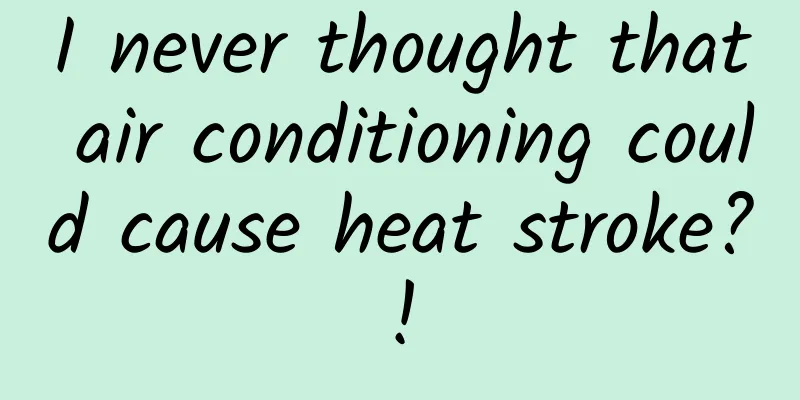I never thought that air conditioning could cause heat stroke?!

|
Recently, there is a rumor about air conditioners that the air conditioner will shut down when the ambient temperature is too high, the temperature exceeds 60℃, which is far beyond the operating temperature of the air conditioner, etc. This statement is partially true, but it is a bit exaggerated . Let's talk about it in detail below. From Weibo This summer has entered the dog days of summer, and hot days are coming one after another in various places. Everyone feels that air conditioning has saved them. However, have you ever thought that although air conditioning can bring a little coolness to thousands of households, when the temperature reaches a certain level, the air conditioner itself will "get heat stroke" and shut down... It turns out that air conditioners also have a suitable operating temperature range. If the temperature is too high, it may trigger the air conditioner's protection mechanism and automatically shut down, which will bring you a sour day - in the weather where even the air conditioner is so hot that you get "heatstroke", just imagine how you would feel without air conditioning... So, why does air conditioning cause heat stroke? And how can we prevent it? 01 Air conditioning "heatstroke", what exactly happened? To explain this problem, we must first have a brief understanding of the principles of air conditioning refrigeration. We have all had injections and blood drawn. When we use alcohol cotton to disinfect, we feel a cool sensation on our skin. This is because the liquid alcohol evaporates and turns into alcohol vapor, taking away a lot of heat in the process. Do you remember the feeling of alcohol sprayed on your body? | Tuchong Creative The basic principle of air conditioning is similar to that of air conditioning, which relies on liquid refrigerant to vaporize in the evaporator (the densely packed structure in the indoor unit of the air conditioner) to absorb heat and cool down. Of course, we cannot cool down by filling the air conditioner evaporator with refrigerant one by one, so we also need a compressor and a condenser (these two are usually installed in the outdoor unit) to pressurize and cool the gaseous refrigerant coming out of the evaporator, and then re-enter the evaporator to vaporize. In this way, the refrigerant circulates over and over again, and the room temperature also drops. However, this process is not easy. Let's talk about the compressor first. When the air conditioner compressor is working, the high-pressure part can reach a pressure of more than 2.2Mpa, which is about 22 standard atmospheres . The pressure of the pressure cooker we usually use can usually only reach 0.18Mpa, which is less than 2 standard atmospheres. Moreover, the higher the ambient temperature, the harder the compressor works. In order to reach the set temperature of the air conditioner in the house, it will run longer and consume more electricity. The higher the ambient temperature, the heavier the air conditioning refrigeration burden | Tuchong Creative Let's talk about the condenser. Its function is to cool down the high-pressure gaseous refrigerant after being processed by the compressor, turning it back into liquid. This process requires a lot of heat to be released, so a strong fan is needed to let air flow through the condenser to dissipate heat. When the ambient temperature is high, the heat dissipation efficiency will also decrease. In addition to the heat released by the refrigerant, the machine itself also generates heat when the compressor and fan are working. If the ambient temperature is too high, the heat dissipation effect will deteriorate, which will cause the air conditioner to overheat, which may cause device failure, damage, or even fire. Therefore, air conditioners have overheat protection devices. If the air conditioner temperature is too high, it will automatically shut down, so the air conditioner "gets heat stroke". 02 At what temperature will air conditioning cause heat stroke? So at what temperature will the air conditioner automatically shut down? This mainly depends on the ambient temperature, as well as the performance and status of the air conditioner itself. According to the 2019 version of the national standard GB/T 7725 "Room Air Conditioners" for air conditioners, the most common air conditioner in China is suitable for the climate type T1. This type of air conditioner should be able to work normally as long as the ambient temperature is below 43°C. From GB/T 7725-2019 Room Air Conditioner Of course, air conditioner manufacturers often leave some margin to deal with extreme situations. Therefore, even if the ambient temperature exceeds 43℃, the air conditioner will still work. Fortunately, in most parts of my country, the highest summer temperature usually does not exceed the 43℃ upper limit of the air conditioner standard. It is not common for the ambient temperature to be too high to trigger thermal protection and cause the air conditioner to shut down. As for the rumor that the outdoor ground temperature is 60 degrees, which is far beyond the normal operating range of air conditioning, it confuses the concepts. Because the "ambient temperature" we are talking about usually refers to the atmospheric temperature at the equipment operation site or the atmospheric temperature near the air inlet. For a properly installed air conditioner with sufficient heat dissipation, this ambient temperature can be said to be approximately equal to the air temperature at the location. The air temperature is the temperature of the thermometer in the louvered box 1.5 meters above the ground on the lawn of the meteorological department's observation station. As for the ground surface temperature, as the name implies, it is the temperature of the ground. Due to direct sunlight, on sunny days, the ground surface temperature can easily reach 50-60℃, while the air temperature is only 30-40℃. As we all know, air conditioner outdoor units are hung outside, not buried in the ground... So the use of the ground temperature in the above picture to illustrate that it is far higher than the air conditioner operating temperature is alarmist and should be ignored. Tuchong Creative Some readers may wonder, why is the air conditioner shut down when the temperature here is not even 43℃? Let's analyze the reasons and see what to do. 03 How can you “avoid the heat” with the air conditioner? The air conditioner turns on overheat protection because the temperature of the equipment is too high. Even if the ambient temperature is not very high, as long as there is too much heat or poor heat dissipation, it may still cause overheating. To avoid this situation, we can do the following: 1. Proper installation When installing an air conditioner, be sure to consider heat dissipation and leave enough heat dissipation space around the outdoor unit. A simulation study found that if the outdoor unit of the air conditioner is installed too closely, it will cause the ambient temperature in the area to rise, affecting heat dissipation. In addition, some buildings hide the outdoor unit in a small compartment for the sake of aesthetics, and add blinds. Although it looks beautiful, if the blinds and small compartments are not designed well, the temperature of the air inhaled by the outdoor unit may rise to more than 50°C [1], which will put a heavy burden on the air conditioner and trigger thermal protection. Therefore, for air conditioners that are mainly used for cooling, when installing the air conditioner, you need to choose a location with good ventilation and less sunlight as much as possible. 2. Regular maintenance Good air circulation is essential for air conditioning heat dissipation. If the air flow channel is blocked by dirt, or the fan cannot rotate freely due to excessive dust accumulation, overheating protection may occur even if the ambient temperature is not high. Refrigerant is the medium used to "transport" heat when the air conditioner is working. If the air conditioner is used for many years and the refrigerant is lost too much, the cooling efficiency will decrease, and the outdoor unit will work so hard that it will overheat. In addition, the outdoor unit is hung outside and exposed to wind and sun all year round. Some original parts may age and become more heat-resistant, causing failures and shutdowns. Therefore, the air conditioner needs to be cleaned and maintained regularly to keep it in good working condition. To use the air conditioner in a healthy way, the indoor unit should also be cleaned regularly | Tuchong Creative 3. Fair Use Under the premise of being relatively comfortable, we can set the air conditioner temperature between 26-30℃ in summer to reduce the burden of the air conditioner and save electricity. The air conditioner can keep us cool, but it is not necessary to use the air conditioner to keep us cool. For example, you can use a small fan to circulate the air while using the air conditioner. If no one is at home during the day, you can also draw the blackout curtains, so that the temperature in the room rises slowly and the air conditioner does not need to work for a long time to cool down. In midsummer, it is easy for heat to accumulate in the room when the curtains are opened | Tuchong Creative Finally, the air conditioner does have an overheating protection mechanism. If the temperature of the components is too high, the protection will be triggered and the air conditioner will shut down. However, high temperature is only one of the reasons. Improper installation, poor maintenance, and excessive load may also cause the air conditioner to overheat. In such a hot summer, take good care of your air conditioner, and the air conditioner will take good care of you. Author | Ding Zong Review | Qin Zongmin Member of the Chinese Society of Refrigeration Senior Engineer [1] Jiang Yuebo, Jin Wufeng, Liu Yang, et al. Numerical simulation of thermal environment around air conditioner outdoor unit under different installation conditions [J]. Fluid Machinery, 2013, 41(9):5. This article is produced by Science Popularization China-Creation and Cultivation Program. Please indicate the source when reprinting. The pictures in this article are from the copyright gallery and are not authorized for reproduction. |
Recommend
WeChat Mini Program fission marketing, how to play the mini program fission distribution system?
General mini-program e-commerce malls can only co...
How much money is appropriate to invest in WeChat promotion? How is it charged? What types of promotions are there?
Recently, fans often ask me, how much money is ap...
As compact celestial bodies formed by the collapse of stars, their "collision" may reveal the ultimate mystery of the universe
Author: Duan Yuechu A neutron star is an extremel...
Game engine learning notes: introduction, architecture, design and implementation
[[120519]] Although I have played many games sinc...
If all the seawater on Earth becomes fresh water, will human life be better? The blue planet may no longer have vitality
As we all know, the Earth on which we live is a v...
The Ministry of Industry and Information Technology will issue "22 regulations": APP rights requests should be based on the principle of minimum necessity
Mobile phone apps unscrupulously collect personal...
Win8 is officially retired! Return to Win7 or upgrade to Win10?
In recent days, when searching for "Microsof...
If you are addicted to oranges and eat one after another, be careful of hyperkalemia. This group of people should be especially vigilant!
In winter, what is the protagonist among fruits? ...
3 questions and 5 steps to help you create a successful online event
When doing an online event, we often feel uncerta...
Mobile game industry optimization methodology, classic material cases packaged for you!
Not long ago, Tencent released its Q2 financial r...
Do you think you can operate well just by reading the dry goods? Stop dreaming!
Just like I have heard a lot of truths, but I sti...
Android apps will soon run on Chrome
Google has had the idea of allowing Chrome OS t...
Frequent illness vs. no illness, who has a stronger immune system? Let's talk about immunity
This week is "World Immunization Week" ...
Aite Tribe Administrator Recruitment Order
[51CTO.com original article] Dear developers: 51C...
How to optimize advertising creatives to increase efficiency by 50%?
“It is important to have a teacher in learning, b...








![[Smart Farmers] Looking at the Wandering Earth from an agricultural perspective: If the Earth were wandering, what would humans eat?](/upload/images/67f246af196b7.webp)
